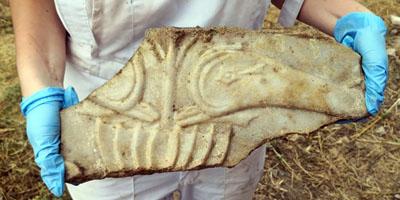2019 season
Excavation and survey work at the site in 2019.

In the 2019 season we expanded our investigations to two new areas of the city not previously touched by us: the peristyle houses in the city centre, which had been excavated in the 1950s, and the south-western ridge, which had not been worked on at all. The two trenches in the peristyle house were opened to investigate the structure’s dating and the phasing of its wall, since most of the documentation relating to the original excavations does not survive. These trenches confirmed that this house, in its current form, is mostly of late-antique date; however, it was certainly built on the site of an earlier imperial domus and made us of many of its walls and building materials. Beneath this imperial structure, however, other walls, some possibly using mudbrick, confirm that this part of the city had been intensively occupied for centuries, probably since the Republican period. From the perspective of understanding late-antique Aeclanum, these new results show that this large house was renovated and occupied at the same date as the large Christian basilica was built just across the street, and it is tempting to see a connection between these projects.
On the south-western ridge of the city, where we undertook intensive GPR in the 2018 season, we opened a new trench to ground test the geophysics results. This trench confirmed that here, unlike in other areas of the city, deep stratigraphy is exceptionally well preserved, and there is little evidence for post-antique interventions. Here a series of walls and room were uncovered built on terraces, and probably belonging to residential units. These were certainly occupied into the 4th and perhaps 5th centuries AD, though the area suffered from earthquake damage, which is probably to be connected to the AD 346 earthquake that we know struck the territory.
The final trench in 2019 was focused once more on the macellum, a building we first explored in 2017. This new trench targeted the northern side of the building and again provided important insights into the unusual plan of the building, as well as its later phases, when it seems to have been turned into a domestic space.nn

